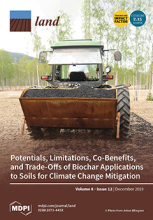Land Library
Welcome to the Land Portal Library. Explore our vast collection of open-access resources (over 74,000) including reports, journal articles, research papers, peer-reviewed publications, legal documents, videos and much more.
/ library resources
Showing items 1 through 9 of 165.Growing external pressures from human activities and climate change can exacerbate desertification, compromising the livelihoods of more than 25% of the world’s population.
Long-term studies on plant response mechanisms to different irrigation regimes will provide a better understanding of the survivability and establishment of plant communities in a desert environment.
From its origins, the concept of desertification has been controversial. The prevailing confusion between two desertification visions, one that considers it as the expansion of deserts and another that emphasizes its anthropogenic component, has been transferred to society.
Desertification is defined as land degradation occurring in the global drylands. It is one of the global problems targeted under the Sustainable Development Goals (SDG 15).
The process of desertification is complex, involving interaction between many factors, both environmental and anthropogenic. However, human activities, especially from land-use change and inappropriate land use, are the most influential factors associated with the desertification risk.
The United Nations Convention to Combat Desertification defines ‘land degradation’ as a reduction or loss of the biological and economic productivity resulting from land-use mismanagement, or a combination of processes, such as soil erosion, deterioration of soil properties, and loss of natural v
Land-use planning (LUP), an instrument of land governance, is often employed to protect land and humans against natural and human-induced hazards, strengthen the resilience of land systems, and secure their sustainability.
Land-use planning (LUP), an instrument of land governance, is often employed to protect land and humans against natural and human-induced hazards, strengthen the resilience of land systems, and secure their sustainability.
Across the Gobi Desert in China and Mongolia, millions of newly planted trees struggle to survive amid adverse ecological conditions.








